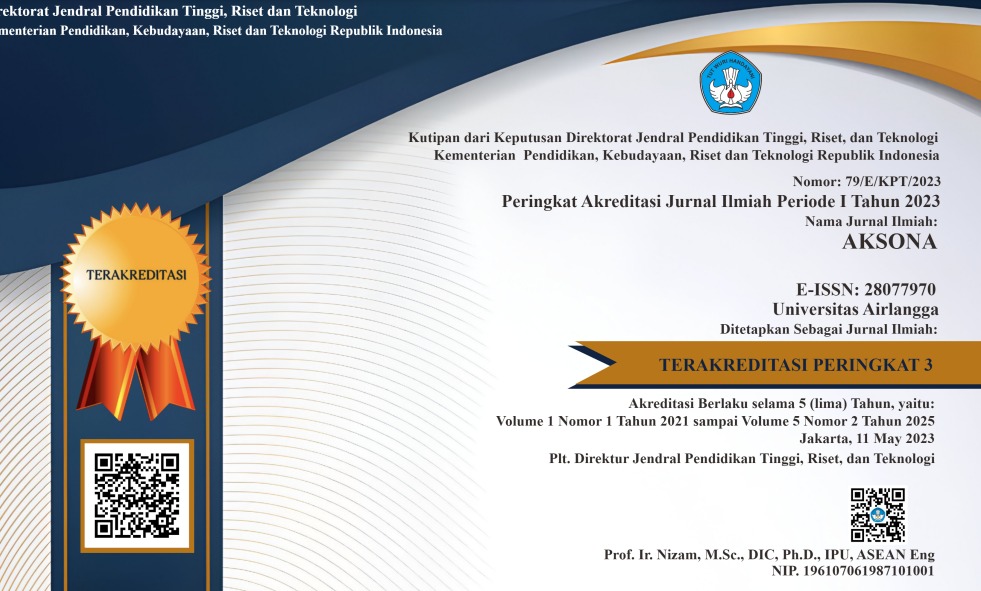Intracerebral Hemorrhage Score as a Prognosis Prediction of Spontaneous Intracerebral Hemorrhage at RSI Surabaya Jemursari
Downloads
Highlight:
- Spontaneous intracerebral hemorrhage, or hemorrhagic stroke, is one of the leading causes of mortality and disability in Indonesia.
- The intracerebral hemorrhage (ICH) score is a widely used predictive tool for the prognosis of death 30 days after spontaneous intracerebral hemorrhage, but the intracerebral hemorrhage-grading scale (ICH-GS) score has a more specific interval to assess prognosis prediction after intracerebral.
- The higher the total score, the more likely it is to have a poor outcome. The results of this study indicate that patients with a high total score did not always die.
ABSTRACT
Introduction: Spontaneous intracerebral hemorrhage, or hemorrhagic stroke, is one of the leading causes of mortality and disability in Indonesia. Objective: The intracerebral hemorrhage (ICH) score is a widely used predictive tool for the prognosis of death 30 days after spontaneous intracerebral hemorrhage, but the intracerebral hemorrhage-grading scale (ICH-GS) score has a more specific interval to assess prognosis prediction after intracerebral hemorrhage. Methods: The type of research used was observational-retrospective research. The population included all patients with spontaneous intracerebral hemorrhage hospitalized at RSI Jemursari Surabaya in 2017–2019. Results: The results revealed that there were 110 spontaneous intracerebral hemorrhage patients with complete data in medical e-records during 2017–2019; 65.5% (72 patients) were male and 34.5% (38 patients) were female. The data showed that 20% (22 patients) had an ICH-GS score of 8 and 0.9% (1 patient) had an ICH-GS score of 12. Conclusion: The higher the total score, the more likely it is to have a poor outcome. The results of this study indicate that patients with a high total score did not always die.
P2PTM Kemenkes RI. Hari stroke sedunia 2019: Otak sehat, SDM unggul. Kementerian Kesehatan Republik Indonesia. 2019. Available from: https://p2ptm.kemkes.go.id/tag/hari-stroke-sedunia-2019-otak-sehat-sdm-unggul
American Stroke Association. About stroke. Available from: https://www.stroke.org/en/about-stroke
Anindhita T, Wiratman W. Buku ajar neurologi. II. Jakarta: Departemen Neurologi FK UI; 2017.
Sulistyowati LS. Kebijakan dan strategi pencegahan dan pengendalian stroke di Indonesia. Direktorat Jenderal Pencegahan dan Pengendalian Penyakit Kementerian Kesehatan RI. 2017.
American Heart Association. The hemorrhagic stroke initiative aims to extend and improve patients' lives. 2023. Available from: https://www.heart.org/en/professional/quality-improvement/hemorrhagic-stroke
Ziai WC, Carhuapoma JR. Intracerebral hemorrhage. Contin Lifelong Learn Neurol. 2018;24(6):1603–22.
Ruiz-Sandoval JL, Chiquete E, Romero-Vargas S, Padilla-MartiÌnez JJ, GonzaÌlez-Cornejo S. Grading scale for prediction of outcome in primary intracerebral hemorrhages. Stroke. 2007;38(5):1641–4.
Aysenne AM, Albright KC, Mathias T, Chang TR, Boehme AK, Beasley TM, et al. 24-Hour ICH score is a better predictor of outcome than admission ICH score. ISRN Stroke. 2013;2013:1–4.
Maljaars J, Garg A, Molian V, Leira EC, Adams HP, Shaban A. The intracerebral hemorrhage score overestimates mortality in young adults. J Stroke Cerebrovasc Dis. 2021;30(9):105963.
Unnithan AKA, M Das J, Mehta P. Hemorrhagic stroke. StatPearls. Treasure Island (FL): StatPearls Publishing; 2022.
Jolink WMT, Wiegertjes K, Rinkel GJE, Algra A, de Leeuw F-E, Klijn CJM. Location-specific risk factors for intracerebral hemorrhage. Neurology. 2020;95(13):e1807–18.
Ciochon U, Bindslev J, Hoei-Hansen C, Truelsen T, Larsen V, Nielsen M, et al. Causes and risk factors of pediatric spontaneous intracranial hemorrhage”A systematic review. Diagnostics. 2022;12(6):1459.
Kim MG, Gandhi C, Azizkhanian I, Epstein B, Mittal A, Lee N, et al. Frailty and spontaneous intracerebral hemorrhage: Does the modified frailty index predict mortality? Clin Neurol Neurosurg. 2020;194:105816.
Nzwalo H, Nogueira J, Félix C, Guilherme P, Baptista A, Figueiredo T, et al. Incidence and case-fatality from spontaneous intracerebral hemorrhage in a southern region of Portugal. J Neurol Sci. 2017;380:74–8.
Batista A, Osório R, Varela A, Guilherme P, Marreiros A, Pais S, et al. Prediction of short-term prognosis in elderly patients with spontaneous intracerebral hemorrhage. Eur Geriatr Med. 2021;12(6):1267–73.
Zhang T, Chen R, Wen D, Wang X, Ma L. The prognostic value of the Charlson comorbidity index in aged patients with intracerebral hemorrhage. BMC Neurol. 2022;22(1):443.
Bender M, Haferkorn K, Tajmiri-Gondai S, Uhl E, Stein M. Fibrinogen to albumin ratio as early serum biomarker for prediction of intra-hospital mortality in neurosurgical intensive care unit patients with spontaneous intracerebral hemorrhage. J Clin Med. 2022;11(14):4214.
Forti P, Maioli F, Domenico Spampinato M, Barbara C, Nativio V, Coveri M, et al. The effect of age on characteristics and mortality of intracerebral hemorrhage in the oldest-old. Cerebrovasc Dis. 2016;42(5–6):485–92.
Imaoka Y, Kawano T, Hashiguchi A, Fujimoto K, Yamamoto K, Nishi T, et al. Modified frailty index predicts postoperative outcomes of spontaneous intracerebral hemorrhage. Clin Neurol Neurosurg. 2018;175:137–43.
Forman R, Slota K, Ahmad F, Garg R, John S, Da Silva I, et al. Intracerebral hemorrhage outcomes in the very elderly. J Stroke Cerebrovasc Dis. 2020;29(5):104695.
Inoue Y, Miyashita F, Minematsu K, Toyoda K. Clinical characteristics and outcomes of intracerbral hemorrhage in very elderly. J Stroke Cerebrovasc Dis. 2018;27(1):97–102.
Copyright (c) 2023 Dyah Yuniati, Shobihatus Syifak, Prima Ardiansah Putra, Vena Saskia Prima Saffanah

This work is licensed under a Creative Commons Attribution-ShareAlike 4.0 International License.





















